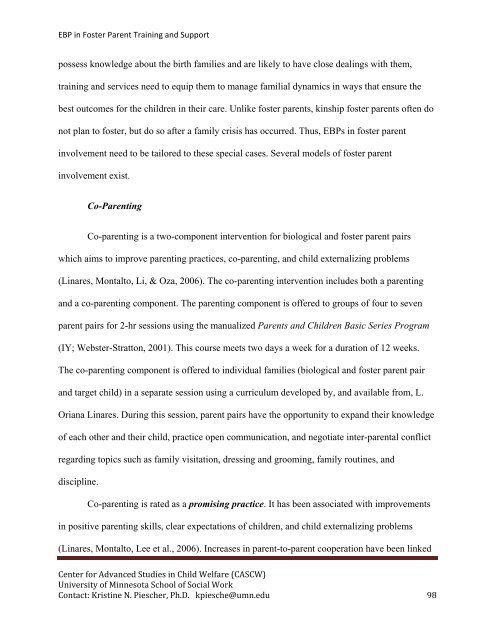Evidence-Based Practice in Foster Parent Training and Support ...
Evidence-Based Practice in Foster Parent Training and Support ...
Evidence-Based Practice in Foster Parent Training and Support ...
You also want an ePaper? Increase the reach of your titles
YUMPU automatically turns print PDFs into web optimized ePapers that Google loves.
EBP <strong>in</strong> <strong>Foster</strong> <strong>Parent</strong> Tra<strong>in</strong><strong>in</strong>g <strong>and</strong> <strong>Support</strong>possess knowledge about the birth families <strong>and</strong> are likely to have close deal<strong>in</strong>gs with them,tra<strong>in</strong><strong>in</strong>g <strong>and</strong> services need to equip them to manage familial dynamics <strong>in</strong> ways that ensure thebest outcomes for the children <strong>in</strong> their care. Unlike foster parents, k<strong>in</strong>ship foster parents often donot plan to foster, but do so after a family crisis has occurred. Thus, EBPs <strong>in</strong> foster parent<strong>in</strong>volvement need to be tailored to these special cases. Several models of foster parent<strong>in</strong>volvement exist.Co-<strong>Parent</strong><strong>in</strong>gCo-parent<strong>in</strong>g is a two-component <strong>in</strong>tervention for biological <strong>and</strong> foster parent pairswhich aims to improve parent<strong>in</strong>g practices, co-parent<strong>in</strong>g, <strong>and</strong> child externaliz<strong>in</strong>g problems(L<strong>in</strong>ares, Montalto, Li, & Oza, 2006). The co-parent<strong>in</strong>g <strong>in</strong>tervention <strong>in</strong>cludes both a parent<strong>in</strong>g<strong>and</strong> a co-parent<strong>in</strong>g component. The parent<strong>in</strong>g component is offered to groups of four to sevenparent pairs for 2-hr sessions us<strong>in</strong>g the manualized <strong>Parent</strong>s <strong>and</strong> Children Basic Series Program(IY; Webster-Stratton, 2001). This course meets two days a week for a duration of 12 weeks.The co-parent<strong>in</strong>g component is offered to <strong>in</strong>dividual families (biological <strong>and</strong> foster parent pair<strong>and</strong> target child) <strong>in</strong> a separate session us<strong>in</strong>g a curriculum developed by, <strong>and</strong> available from, L.Oriana L<strong>in</strong>ares. Dur<strong>in</strong>g this session, parent pairs have the opportunity to exp<strong>and</strong> their knowledgeof each other <strong>and</strong> their child, practice open communication, <strong>and</strong> negotiate <strong>in</strong>ter-parental conflictregard<strong>in</strong>g topics such as family visitation, dress<strong>in</strong>g <strong>and</strong> groom<strong>in</strong>g, family rout<strong>in</strong>es, <strong>and</strong>discipl<strong>in</strong>e.Co-parent<strong>in</strong>g is rated as a promis<strong>in</strong>g practice. It has been associated with improvements<strong>in</strong> positive parent<strong>in</strong>g skills, clear expectations of children, <strong>and</strong> child externaliz<strong>in</strong>g problems(L<strong>in</strong>ares, Montalto, Lee et al., 2006). Increases <strong>in</strong> parent-to-parent cooperation have been l<strong>in</strong>kedCenter for Advanced Studies <strong>in</strong> Child Welfare (CASCW)University of M<strong>in</strong>nesota School of Social WorkContact: Krist<strong>in</strong>e N. Piescher, Ph.D. kpiesche@umn.edu 98
















